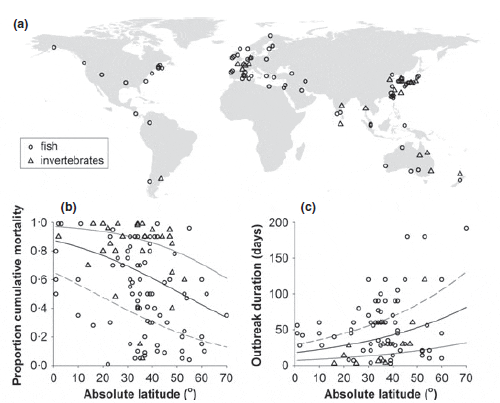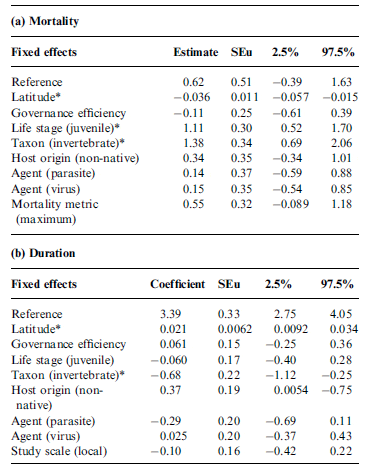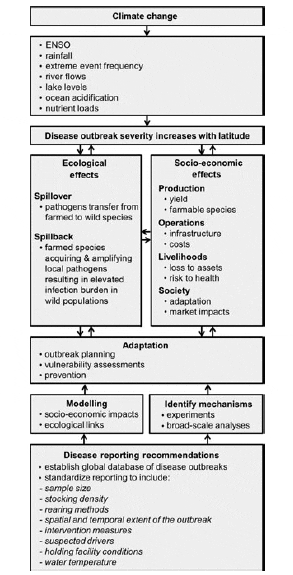Food security is a pressing global issue as the human population is projected to reach between 7.5 and 10.5 billion by 2050 (UNPD 2006). With capture fisheries becoming increasingly unsustainable due to overfishing, aquaculture is expected to overtake capture fisheries in supplying the world’s protein requirements in the future (FAO 2012).
Indeed, aquaculture is the fastest growing food production sector in the world, with an average annual growth rate of 6.3% since 2000 (average 8.8% per year between 1980 and 2010) and currently accounts for approximately 47% of the world’s fish supply (FAO 2012). Although the precise impacts and direction of climate-driven change for particular fish stocks and fisheries are uncertain, in countries which depend heavily upon fisheries for their livelihood, climate change is expected to result in increased economic hardship or missed opportunities for development (Allison et al. 2009).
These countries are also the most vulnerable to the effects of climate change as they have the least capacity to implement adaptive actions (Dulvy et al. 2011). Aquaculture is expected to contribute to food security and improving the socio-economic status of developing countries (Godfray et al. 2010) and thus provide adaptive capacity to the effects of climate change and food shortages.
However, aquaculture may not be a panacea for food security. As in other forms of intensive and semi-intensive agriculture, infectious disease is a major problem. Waterborne pathogens can spread at faster rates than in terrestrial systems (McCallum, Harvell & Dobson 2003), and oceanographic transport processes have the potential to transmit disease across vast geographic regions, for example, pilchard herpesvirus was spread to >5000 km of Australian coastline at 30 km day 1 (Whittington et al. 1997).
In fact, infectious disease is by far the biggest killer of farmed fishes (Pillay & Kutty 2005); an outbreak can often wipe out entire stocks, requiring costly decontamination of the associated facilities and equipment (Pillay & Kutty 2005), and has been identified as a potential limiting factor to aquaculture production (Jansen et al. 2012). The epidemiological issues associated with aquaculture will also be exacerbated by climate change (Karvonen et al. 2010). Extreme weather events are predicted to become more severe and more frequent in the future (IPCC 2007) favouring pathogen outbreaks following seasonal periods associated with changes in temperature and precipitation (Altizer et al. 2006). Additionally, increases in temperature are expected to lead to the introduction of pathogens to new regions by producing environmental conditions that favour pathogen growth and transmission (Harvell et al. 2002).
In spite of the expected issues with disease in aquaculture settings, the underlying global patterns in disease outbreaks have not been identified. However, in natural systems, the number of parasite or pathogen species infecting each host species tends to be higher at the lower latitudes (Rohde & Heap 1998; Guernier, Hochberg & Guegan 2004; Nunn et al. 2005), as well as reaching higher infection intensity (Calvete 2003; Benejam et al. 2009) and prevalence (Merino et al. 2008). Infectious disease– related mortalities are also more likely to occur at lower latitudes where relatively warmer climate promotes higher pathogen proliferation and transmission rates (Robar, Burness & Murray 2010).
Thus, the ecological literature certainly suggests that similar patterns may be present in aquacultural systems, but this has not been investigated perhaps due to the assumption that such patterns will be mitigated by disease control measures. Establishing whether macroecological patterns of infectious disease are present in farmed settings can contribute valuable insights into the environmental drivers of diseases and appropriate management procedures for outbreaks. For example, ecological theories have facilitated the development and implementation of control measures for human infectious diseases and public health policies (Smith et al. 2005).
The potential for disease outbreak dynamics to be mediated by changes in climate and impact food production highlights the importance of establishing the current macroecological patterns of disease outbreaks in aquaculture at a global scale. Baseline epidemiological patterns will aid predictions of future outbreak patterns and contribute to building forward thinking aquaculture infrastructure and adaptive management strategies.
Here, we analysed the epidemiological pattern of disease outbreaks in aquaculture across the globe (Fig. 1a) using data from published sources on disease outbreaks that have occurred in aquaculture facilities (see Table S1, Supporting information). We quantified the severity and duration of disease outbreaks across latitude for juvenile and adult stages of various fish and invertebrate species infected by viral, bacterial and parasitic disease-causing agents. Origin and life stage of each host were additional explanatory factors. To account for variation in veterinary and disease reporting infrastructure, which is expected to differ between countries, we also included an index of governance efficiency that considers the quality of policy formation and implementation among other aspects of governance (The World Bank Group 2011). Finally, because cumulative mortality was reported as either a total or a maximum value and outbreak duration was for either local (e.g. tank, pond, net, single site) or regional scales (e.g. multiple farms), we also included those information as factors.

Results
We found that outbreak severity (in terms of cumulative mortality) was relatively higher in the tropics where outbreaks lead to an average cumulative mortality of 88% at the equator (Fig. 1b) and declined in temperate systems to 34% at 70° absolute latitude (Table 1a). Juvenile invertebrates were relatively more vulnerable in comparison with adult finfish, where at the equator, proportion cumulative mortality was, respectively, 0.96 vs. 0.65 (back-transformed parameter estimates where additional fixed factors and covariates equalled the reference: Table 1a). Disease outbreaks also proceeded more rapidly in the tropics; maximum outbreak duration at the equator was 60 days, whereas outbreaks in temperate regions were reported over durations of up to 192 days (Fig. 1c). Invertebrates tended to suffer more rapid disease progression than adult fish, with equatorial outbreaks lasting on average 15 vs. 30 days (back-transformed parameter estimates where additional fixed factors and covariates equalled the reference: Table 1b).

Discussion
The latitudinal trend in disease outbreak severity and duration may in part be explained by human factors such as the effectiveness of management practices, policy implementation and reporting infrastructure. There may be better fish disease monitoring and control measures available for countries at higher latitudes, and indeed, government efficiency correlated positively with latitude (Fig. 2). However, government efficiency did not show a significant relationship with outbreak characteristics (Table 1), even when latitude was removed as a model covariate (see Table S3, Supporting information). Moreover, these trends cannot be explained by different management practices and disease control capacity in different regions because we excluded studies where intervention ended an outbreak or reduced its severity.
Overall, our findings indicate that the increase in aquaculture disease impacts towards the tropics is likely to be driven (at least in part) by environmental factors. In natural systems, infectious disease–related mortality is also more likely to occur at lower latitudes where relatively warmer climate promotes higher pathogen proliferation and transmission rate (Robar, Burness and Murray 2010). Here, we demonstrate that this trend similarly applies to aquaculture populations. When combined with the crowded conditions of aquaculture facilities and warmer temperatures, this provides ideal conditions for outbreaks (Krkosek 2010; Mennerat et al. 2010; Salama & Murray 2011) that can lead to more severe mortality and rapid progression of diseases.
Additionally in the last 50 years, lower latitudinal regions have also seen the greatest increase in nitrogen deposition (McKenzie & Townsend 2007). Higher nutrient loading is associated with increased risk of infectious diseases, for instance, nitrogenous compounds present in run-off can challenge host immune responses and promote pathogen replication rate (Martin et al. 2010). Thus, future research should seek to identify the environmental parameters and management system parameters at lower latitudes, which contribute to the pattern of higher mortality and rapid disease progression associated with epizootics.
The role of disease in limiting the aquaculture-based production of fish and shellfish has not been considered in empirical calculations of regional vulnerability to climate change (Handisyde et al. 2009). An important implication of our findings is that the aquaculture industry will need to focus on building the capacity to minimize and recover from pathogen-induced loss, an issue of greatest priority in tropical regions. There are different management approaches to minimizing vulnerabilities in aquaculture, such as investing in environmental monitoring infrastructure and steering towards sustainable production (Bush et al. 2010). Even so, any management framework should also take into account economic losses from disease outbreak (Karim et al. 2012).
While aquaculture is considered a viable means to promote food security and improve socio-economic status of developing countries (Godfray et al. 2010), lower latitudinal regions have also been identified as being most vulnerable to the effects of climate change (Dulvy et al. 2011). Environmental change is expected to reduce available agricultural land and crop yield at lower latitudinal regions (Schmidhuber & Tubiello 2007) in additional to the productivity of capture fisheries (Cheung et al. 2010). Combined with the region’s heavy dependency on fish protein (Allison et al. 2009; Dulvy et al. 2011) and the fact that 90% of the world’s aquaculture production comes from developing countries (FAO 2012), our data present a strong case for considering the potential impacts of disease outbreaks in strategies to build infrastructure for food security in developing nations as a global priority.
Our results also suggest further directions for management consideration. For instance, juvenile stages displayed higher levels of disease-induced mortality than adults (Table 1a). This may be because the immune system of juveniles is not as fully developed compared with mature individuals. Additionally, juvenile stages have fewer resources to draw from to mount an effective response to infection without compromising other functions necessary for survival; thus, strategies to minimize mortality at juvenile stages will be important. We also found a general trend of higher mortality and shorter outbreak duration in invertebrates compared to finfish (Table 1). As invertebrates account for 35% of the world’s total aquaculture production by volume (FAO 2012), mostly from low latitudinal regions (particularly crustaceans) (FAO 2010), research contributing to building disease resilience in shrimp and shellfish culture will be of primary importance to protecting food and socio-economic security.
Future of Disease Outbreaks in Aquaculture
Aquaculture in tropical regions has the potential for greater economic loss in comparison with temperate regions due to climate change–mediated disease mortality in the light of current forecasts of decreasing water quality and supply and increasing frequency of extreme weather events (Handisyde et al. 2009). Moreover, environmental deterioration may be more severe in tropical nations and interact with climate change outcomes, which are predicted to increase the frequency and risk of disease (Harvell et al. 2002), as well as altering the distribution and severity of disease outbreaks (Rohr et al. 2011). It will be important to monitor such emerging trends to implement adaptive management strategies as climatic and nutrient deposition patterns may act synergistically to result in even greater frequency of disease-induced stock mortalities in aquaculture.
There are also important ecological ramifications associated with our findings that should be considered in future risk assessments. Aquaculture operations may be an increasing threat to wild stocks, a problem that may be global in scope and particularly so in tropical nations if disease is not considered in the implementation of open aquaculture facilities. Certain rearing methods, such as cage systems in marine or freshwater systems, can facilitate pathogen exchange between farmed and wild populations (Johansen et al. 2011), leading to pathogen spillover (Krkosek et al. 2006) or spillback (Kelly et al. 2009).
As well as reducing the profitability and sustainability of farming (Salama & Murray 2011; Jansen et al. 2012), pathogen exchange can result in epizootics that threaten a range of wild species, a phenomenon that has been well documented from terrestrial systems (Gottdenker et al. 2005; Colla et al. 2006). Aquacultural settings also have the potential to select for the evolution of more virulent pathogens (Pulkkinen et al. 2010; Mennerat et al. 2012).
The introduction of such pathogens into the surrounding environment via introduced aquaculture species can consequently have devastating impacts on wild fish populations and pose a significant threat to local biodiversity, especially to those species that may be facing a range of threats or occur at low population numbers (e.g. Gozlan et al. 2005).
Coupled with our findings that more severe outbreaks occur at lower latitudinal regions – where biodiversity reaches a maximum (Gaston 2000) – makes the exchange and potential amplification of disease between farmed and nature populations a considerable concern not only for aquaculture sustainability but also its impact on local aquatic fauna and ecosystems.
The risk of acquiring or introducing virulent pathogen to biologically diverse locations should be taken into consideration when selecting sites for aquaculture, thus making biosecurity a key consideration for aquaculture sustainability (Pruder 2004; Lightner 2005; Bush et al. 2010).
While aquaculture systems are typically considered ‘artificial’, the insights gained from studying natural host– parasite systems may have application to outbreaks in aquaculture and in particular where ranching strategies are used. While ecological approaches can be applied to facilitate the development of more effective disease control and management practices, studying disease outbreaks in aquaculture can also broaden our understanding of disease ecology. For example, research in aquaculture has revealed knowledge gaps in certain aspects of disease ecology such as immunology of invertebrates and its interactions with environmental factors (Mydlarz, Jones & Harvell 2006).
Aquacultural systems provide a setting from which disease can be observed and documented in greater detail than outbreaks in the wild. Understanding how outbreaks are initiated and unfold in such settings can further provide insights into the evolutionary ecology of infectious agents, and there is a need for disease ecologists to engage and collaborate with members of aquaculture community.
Recommendations
Aquaculture operations at lower latitudes suffer higher cumulative mortality and faster outbreak progression, which in turn may be exacerbated by climate change, leading to conditions that select for more virulent pathogens (Mennerat et al. 2010). This can result in the introduction of pathogens with greater virulence into wild fisheries, a pattern well documented in terrestrial systems (Gottdenker et al. 2005; Colla et al. 2006). Identifying the environmental mechanisms underlying the relationship between latitude and outbreak severity and epizootic duration will be a fundamental direction for future research (Fig. 3).
Our review of the literature also revealed that many critical details required for in-depth global scale analyses of disease outbreaks often go unreported. Thus, there is a need to standardize the reporting of aquaculture-based epizootics to include key details such as sample size, duration, holding facility conditions, likely contributing factors (apart from the pathogenic agent itself), stocking density, rearing method, water temperature and time of year in which the outbreak occurred (Fig. 3). The requirement of detailed reports on outbreaks serves to highlight the importance of engaging with the aquaculture industry to encourage monitoring and reporting.
Identifying host traits and relative susceptibility to different disease agents under different conditions will be important to generate adaptation strategies that reduce the exposure of farmed animals to extreme climate conditions that stress physiological and immune systems (e.g. by moving net cages to depth when warm weather events are forecasted) and the sensitivity of animals to such exposure (e.g. through selection of thermotolerant genotypes for cultivation). Moreover, preventative actions are required to minimize the potential for common outbreak drivers such as high stock density, injuries following transport, closed rearing methods and open exchange pathways that lead to infection and spread (Bush et al. 2010; Salama & Murray 2011). By limiting the potential for disease outbreaks in combination with efforts to promote adaptive capacity, such as building the required expertise and infrastructure to farm species that are less susceptible to infection under climate change, will reduce the vulnerability of the industry to disease-related economic loss and adaptation efforts (Fig. 3).

Our study indicates that, for aquaculture to become a viable and sustainable option for ensuring food security, particularly in developing countries, any such venture must be integrated with the development of reliable disease management plans and biosecurity infrastructure to promote outbreak prevention and resilience in production systems.
June 2013




